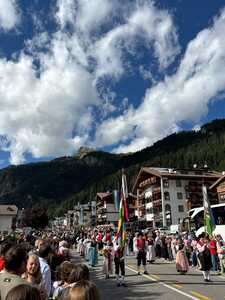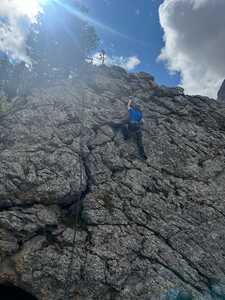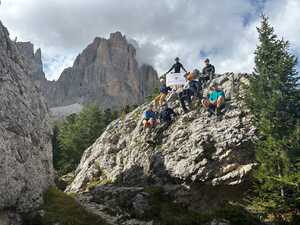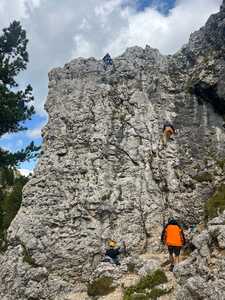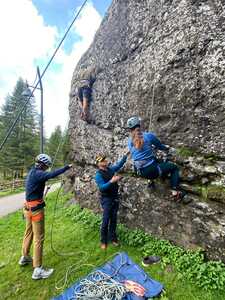On Monday September 8th, nine personnel from Birmingham UOTC set off for the Dolomites to participate in Ex Cadet Slim Gran Festa – a climbing expedition which allowed six Officer Cadets to successfully complete their rock climbing foundation qualification in the Dolomites.
All of the participants gathered at our Army Reserve Centre (ARC) bright and early to start the long drive to Italy. Days one and two were spent travelling, with an overnight stop in Luxembourg to experience the annual Schueberfouer funfair and to rest. After a very soggy night spent in the campsite, we set off for the second half of the drive, until we eventually reached our accommodation in Campitello di Fassa.
The rain showed no signs of slowing on the morning of Wednesday 10th, with the weather forecast predicting heavy rain for the entirety of the day unfortunately making it impossible for us to climb for the day. To ensure we still made good use of the time, we completed many climbing lessons throughout the day. Our instructor (RCI) and supervisor (RCS) led theory lessons in different types of climbing, how difficulty gradings are utilised, and how climbing is affected by different types of rock. Despite being restricted by the weather we still managed to complete some practical lessons indoors. These included tying figure-of-eight and stopper knots, fitting our harnesses and helmets correctly, and effectively checking our equipment for safety risks.
Fortunately the weather had finally dried up by Thursday 11th, so we drove to Città dei Sassi for our first climbing day. After an hour or so of scrambling through the rocks with a few minor navigational challenges, we made it to the wall we were looking for which was sector six named Sasso Cucchi. Our primary goal for the day was to familiarise ourselves with outdoor climbing and belaying, and to gain confidence in tying safe and secure knots. Each climber completed every climb on the wall throughout the day. Every climb was ranked as an easily achievable 4a and was roughly 6m high, which allowed us to focus on perfecting the basics of undertaking safety precautions and controlled single-pitch climbing. Throughout the climbs we had continued coaching on improving our knots and belaying technique from our RCI and RCS, as well as lessons on methods of using hand and foot holds, so that we were able to adapt our climbing to what was required by the routes.
On the morning of Friday 12th, we headed back out to Città dei Sassi for our second climbing day. We located the sector seven wall, Sasso Renato Aspirante, with significantly more ease than the previous day. The climbs we completed on this wall were all graded at a 3a, however the wall itself was much higher at about 22m. This wall was well-textured, allowing us to practice the various different ways of using hand and foot holds that we had learnt the day before. This climbing area provided us with rocks in a variety of shapes, which proved useful during our lesson on how different bits of kit are used for different types of crevices, and allowed us to have a go at inserting nuts and cams securely. We were also introduced to other new bits of equipment, such as slings, a GriGri, different types of carabiners, quickdraws, and nut remover tools. Lessons also touched on how to ensure that any equipment you’re buying is as safe as possible, such as either buying first-hand or knowing the history of the kit, and buying from certain brands which make equipment to specific high safety regulations. In the second half of the day we learnt about steps that can be taken in an emergency situation, such as a climber who has obtained an injury whilst climbing and who is unable to move. We were able to tie off a knot that would support them and were all successful in slowly lowering a climber to the ground without any input from them.
We drove to a new location on Saturday 13th called Penia di Canazei. We started the day off with a lesson on abseil purposes and observing a model of an abseil to figure out what the function of each knot and rope was. We then had a go at tying the knots used in an abseil ourselves until we were familiar with them, such as a clove hitch and a munter hitch. The wall, named Settore Placca, was more technical and challenging than the previous two days. Our RCS lead climbed up the first route, graded at a 5a, to set up the route for the rest of us to be able to use it as a single-pitch climb. This route challenged us and forced us to slow down and spend time visualising how we would attempt different sections of the route and required us to use guidance from peers who were on the ground during the climb. Despite some of the less experienced climbers in the group needing more time to try various techniques before making it up some particularly difficult spots, every group member successfully made it to the top of the climb. The second climb we attempted on this wall was graded at a 6a+, and provided a considerable challenge to even the most experienced of our Officer Cadets. Climbers had some success after many efforts and managed to make it part way up the tricky route, but it proved too challenging for anyone in our group to complete. Despite not completing this route, the Settore Placca wall was certainly a lot of fun and ensured that each individual’s abilities were challenged, despite the varying levels of experience in the group. Back at the accommodation, we finished the day with a lesson on different rope types and how they are used, as well as looking at various ways they can become damaged and how to know when a rope is no longer safe to climb with.
On Sunday 14th the annual Gran Festa da d’Istà took place in Canazei, which is a festival that takes place at the end of the summer season. We gathered with the locals to watch the parade and participate in the celebration that followed, where we experienced local food, drink and music. Some of our group even participated in the dancing and although they had absolutely no knowledge or talent for the traditional style of dance got stuck in to the celebrations anyway.
After an early check-out on Monday 15th, we were sad to be leaving the beautiful scenery of the Dolomites to head back to England. After two days of travel with an overnight stop in Luxembourg, we eventually made it back to the ARC. While disappointed that our surroundings of Birmingham didn’t remotely compare to the wonderful landscapes we had become accustomed to, we were glad to have made it back and had enjoyed a wonderful week away.
Back in Birmingham, we made our way to the ARC again on the morning of Wednesday 17th for our final day of climbing. We travelled to the Creation Climbing Centre for some indoor climbing, which would allow us to be assessed on lead climbing, an essential component of completing the foundation course. We were introduced to different types of indoor climbing that we were not all familiar with, including bouldering, auto-belays, and climbing-focused training areas. While here, we each learnt how to lead climb, and once we felt comfortable doing it on an easy wall, we were assessed in our lead climbs and our belaying. Once established that we had all successfully and safely lead climbed to the top, we reverted back to single-pitch climbing to experiment with different types of indoor holds and walls. We then also had a go at bouldering, which allowed us to try many different difficulty grades and test lots of climbing techniques that we had learnt throughout the week.
“I never expected to enjoy climbing so much, but this expedition has motivated me to develop my skills and pursue my climbing further”
OCdt Heine
The donation from the Ulysses Trust is what facilitated this trip to happen and has provided our Officer Cadets with so much more than just an amazing week in the Dolomites. Six Officer Cadets now have their rock climbing foundation qualification, which has taught them many new skills and has enabled them to safely develop their climbing outside of a course. All participants now have gained valuable experience that will be added to their logbooks that will enable them to progress onto further qualifications. The climbing ability of each participant has also been challenged and developed, which is shown by the progression of climbs from 3a to completing a 5a, and even attempting a 6a+. Additionally, this trip has also inspired a passion for climbing in everyone who attended.

